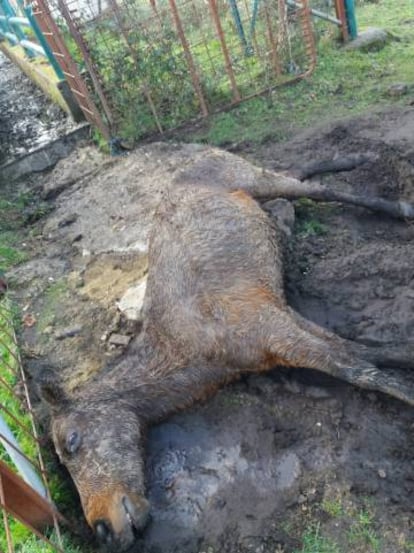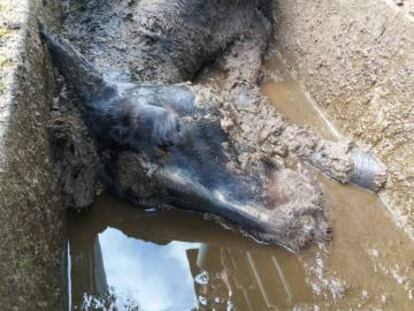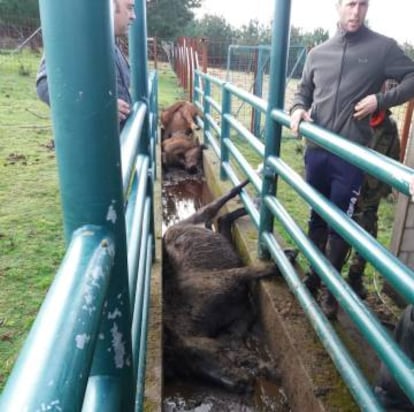Brutal killing of four wild horses shocks Galicia
The endangered animals were found dead in a deworming corridor with blows to the head

When Modesto Dom¨ªnguez arrived on Saturday at 7pm, one of the mares was still breathing. Her skull was sunken in like her three other dead companions, but her suffering had dragged on since Thursday, the day when local ranchers suspect the killing took place. The four horses were squeezed into a deworming corridor for cattle, one after the other, alongside five others who managed to stay alive, in the municipality of Oia, south of Vigo in the northwestern Spanish region of Galicia.

The Civil Guard¡¯s nature protection service Seprona opened an investigation on Monday to find the culprits of the attack on the thousand-year-old, endangered species. Garranos are ponies that belong to the Iberian horse family. They are allowed to run free but are owned by people in the area and annually star in the Rapas das Bestas festival in Galicia, a tradition that involves cutting the manes of these wild horses.
The mares belonged to four different owners from different municipalities of the region, and if the killing was a matter of settling accounts, it is not clear why such measures were taken. Ranchers assured that these animals, although particularly territorial, ¡°bothered no one.¡± They live high up in the mountains, in a very remote area known as O Areeiro (Viladesuso, Oia), where only an ¡°occasional cyclist¡± passes. Getting to where the deworming corridor is located, means crossing a one-kilometer unpaved road, and corralling wild horses to this location requires experience.
?¡°When I arrived, it was already nightfall, and there was rain and snow,¡± explained Dom¨ªnguez, president of the Monte da Groba Horse Association. ¡°I opened the door and the five animals that were alive escaped. Right now we¡¯re searching for them to see how they are, because we don¡¯t know if they were also beaten.¡± As Civil Guard officers and veterinarians, sent by the Galician regional government, took samples of the macabre scene, the ranchers pointed out that the weapon used against the animals was almost certainly an iron bar, which was found lying next to the area where the mares died. They believe that ¡°the intention was to kill all nine,¡± but ¡°some noise,¡± or some other circumstance prevented them from doing so.

Seraf¨ªn Gonz¨¢lez, scientist at the Spanish National Research Council (CSIC)
The massacre was first discovered by owners of cattle, which roam free in the same area, on Saturday afternoon. In fact, the corridor, built by the Community of Montes de Viladesuso, is only used to vaccinate cattle. The metal and reinforced concrete structure helps veterinarians to keep the cows still for their periodic check-ups. The wild horses that were killed lived in a different area, and whoever orchestrated their killing, ¡°had to go through two enclosures with them,¡± before pushing them through the area that leads to the deworming corridor. ¡°It is impossible that it was only one person,¡± explained Arsenio P¨¦rez, president of Montes de Viladesuso.
¡°This hurts us all,¡± he added. ¡°Conflicts between cattle and horse owners don't exist, and these horses did not bother anyone. We knew that they were living nearby, but they didn¡¯t cause any damage, they didn¡¯t go down to inhabited areas and no one saw them.¡± According to P¨¦rez, the attack is ¡°inexplicable,¡± ¡°it can¡¯t be anything else but the work of a psychopath ... to damage our living heritage: these animals are so important for the preservation of this mountain, where we have not had fires since 2006.¡±
Microchips
On Saturday, after having freed the surviving horses and discovering the dead ones, Modesto Dom¨ªnguez called upon all of horse owners of Mount Groba and scanned the dead horses¡¯ microchips to identify them. All of the beaten mares had one due to a 2012 decree issued by the Department of Rural Environment, a measure which was strongly opposed by owners of wild horses in Galicia who argued the expense would be too great.

According to the decree, wild horses captured and not identified by an electronic device or claimed by their owners could be directly sent to the slaughterhouse. The conflict evolved into a long legal battle with the last appeal from two livestock associations reaching the Human Rights Court in Strasbourg last September.
Seraf¨ªn Gonz¨¢lez, a scientist at the Spanish National Research Council (CSIC) and president of the Galician Society of Natural History (SGHN), says the mandatory microchipping of the Garrano horses, a species at risk of disappearing after inhabiting the mountains of the northern peninsula for 20,000 years, has led to a drastic reduction in their numbers over the past six years. Before the decree, there were about 1,300 horses living in the Groba mountains but today there are just around 700.
The SGHN says that ¡°according to recent genetic studies, the Garranos were already here during the Pleistocene time period [a geological epoch which lasted from about 2,588,000 to 11,700 years ago] and are one of the two ancestors of the modern-day horse,¡± adding that ¡°there are genetic, ecological, ethological, morphological and physiological differences¡± between the horse species.
The animal protection society argues that in passing the 2012 decree the ¡°regional Galician government ignored the exceptions to the compulsory identification that the European Commission had made for horses that live in wild or semi-wild situations ... And since then, in Galicia, City Halls can decide to put Garranos found in the mountains without chips for public auctions or ship them to the slaughterhouse.¡±
English version by Asia London Palomba.
Tu suscripci¨®n se est¨¢ usando en otro dispositivo
?Quieres a?adir otro usuario a tu suscripci¨®n?
Si contin¨²as leyendo en este dispositivo, no se podr¨¢ leer en el otro.
FlechaTu suscripci¨®n se est¨¢ usando en otro dispositivo y solo puedes acceder a EL PA?S desde un dispositivo a la vez.
Si quieres compartir tu cuenta, cambia tu suscripci¨®n a la modalidad Premium, as¨ª podr¨¢s a?adir otro usuario. Cada uno acceder¨¢ con su propia cuenta de email, lo que os permitir¨¢ personalizar vuestra experiencia en EL PA?S.
En el caso de no saber qui¨¦n est¨¢ usando tu cuenta, te recomendamos cambiar tu contrase?a aqu¨ª.
Si decides continuar compartiendo tu cuenta, este mensaje se mostrar¨¢ en tu dispositivo y en el de la otra persona que est¨¢ usando tu cuenta de forma indefinida, afectando a tu experiencia de lectura. Puedes consultar aqu¨ª los t¨¦rminos y condiciones de la suscripci¨®n digital.










































